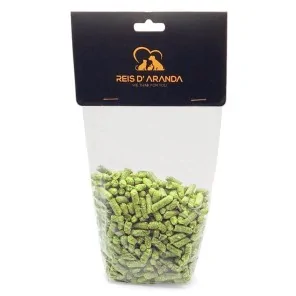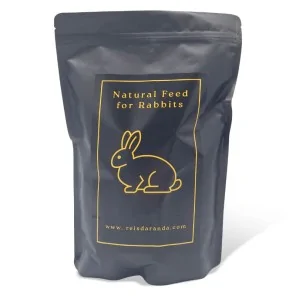Its name says it all: the Vienna blue rabbit comes from Austria. Not only is it beautiful with its shiny blue-grey...
HOW TO CARE FOR AN ORPHANED RABBIT?
On some occasions we have been in the situation of having in our hands the responsibility of bringing up an orphaned rabbits or a litter of orphaned rabbits. What should we do then? What causes them to be considered orphans? Is it only the death of the mother or are there situations that cause orphanhood in the same way?
WHAT CAUSES A RABBIT TO BE CONSIDERED AN ‘ORPHAN’?
When we talk about orphanhood (and therefore about someone being ‘orphaned’) the death of the mother, father or both parents comes to mind; in the case of animals we refer to ‘orphaned animals’ usually when the mother dies, but there can also be other situations in which the mother does not die and the gazapo is still considered ‘orphaned’.
What are these situations?
- DEATH OF THE DAM
- DECEASED BREEDS (hypothermia, lack of nest, mother does not feed them...)
- HIPPIES REJECTED BY THE MOTHER (the mother attacks them for no reason)
- OFFSPRING WHOSE MOTHER HAS NO MILK OR DOES NOT GIVE SUFFICIENT MILK
NEEDS OF THE ORPHANED TOAD
The needs of an orphaned rabbits vary according to the age at which they have ‘lost’ their mother, most orphaned rabbits are newborns or are less than ten days old (an age at which we can be much more relaxed with them), but broadly speaking they need three key things:
- A clean, safe and warm nest, which we will make with soft straw or hay and fur from the mother or another rabbit. We will not use fresh grass, earth, cotton, wool or clothing.
- Constant and safe temperature, as the rabbits are born without hair and are very small in size it is easy for them to become hypothermic, and if the temperatures are very high we can provoke burns by contact or dehydration.
- Controlled humidity. If the humidity in the nest or in the surrounding environment is too high we can cause fungus or hypothermia due to condensation.
- Natural’ milk (from its mother or another lactating doe) or maternised milk (cat or rabbit), some British breeders use goat's milk because of its high fat levels. We will never use cow's milk or any type of skimmed, semi-skimmed or lactose milk as it causes intestinal problems.
HOW DO YOU GET ANOTHER MOTHER RABBIT TO ‘ADOPT’ AN ORPHANED DOE?
Some offspring or entire litters may have the option of being saved in the most natural way possible: by being adopted by another doe, and if the latter accepts them, their salvation is assured.
For this, the litter of the adopting rabbit should not be much older than the orphan litter (maximum three days older), in this way we will make sure that the legitimate gazapos of that rabbit are not too strong and big and prevent the orphans from eating.
Take the mother and take her out of the cage so that she can walk around and be distracted, take the orphan rabbits and rub them gently with hay and feed to eliminate most of the smell of the biological mother and put them in the nest of the adoptive mother, making sure that the legitimate offspring are on top (without crushing them) and cover them again with the hay and hair of the adoptive mother. We will wait about fifteen minutes and we will put the adoptive mother in the cage again, she will go to check if anything has happened and most probably she will not react in any way, we will return after a few hours to check that the orphan pups are sleeping peacefully with their new siblings, and after a few hours we will check if the mother has fed them like the others, if the adoptive pups have eaten and are all calm we can be calm too, as the process has been a success.
We will have to check afterwards that the orphaned pups eat enough, if they don't because the others steal their food we can feed them at different times up to 4 times a day until they are stronger.
RAISING AN ‘ORPHANED RABBIT’ OURSELVES AND COMMON PROBLEMS
The first thing to take into account is whether or not the young rabbits have had some milk from the mother in the first three days. During the first days the mother produces colostrum (a substance a little more yellowish in colour than mother's milk) which contains a large amount of nutrients and natural defences, essential for the immune system of the young, if they do not drink it they can be weak and easily fall ill.
The most suitable milk for kittens is suckling kitten milk (much less nutrient-rich than that for rabbits) or milk for rabbits (some German brands sell it). Some British breeders use whole goat's milk, which is ideal because of its fat and because it comes from an herbivorous animal.
If the rabbits are very young (less than 15 days old) we will have to feed them with a syringe and, although there are very narrow syringes on the market that release drop by drop, although it is true that it is difficult for them to eat with them because they do not like the texture; when they are older we can opt for bottles with narrow teats for cats.
We must sterilise the teats and the bottle before each use, so it is a good idea to get a sterilisation kit. Likewise, milk that is not used at the time should be thrown away, as it is easy for it to spoil.
During the first 10 days of life, we should try to handle the rabbits as little as possible outside feeding times, apart from checking that they are sleeping peacefully and are warm.
Newborn rabbits need to be stimulated to urinate and defecate. This can be done by rubbing their anus genital area with a cotton swab dipped in warm water for 15-30 seconds before feeding. If this does not work, we will try it after eating as well. If we don't get the gazapapo to relieve itself, it may die.
It is important to weigh the gazapos every day with a kitchen scale and write down the progress in a notebook. If they are not gaining weight we should enrich the milk, increase the amount of milk daily or increase the number of feedings. Most hand-fed goslings are slower or stunted in their growth.
The gazapos should drink between 60-90% of their weight in milk (which we will heat up little by little to 40ºC) per day and the daily feedings should be a minimum of three; if they have had enough during the day they can go for 8 hours without eating during the night.
From 2 weeks of age the rabbits will start to eat hay and from 21 days of age they will try feed. We should continue to give them colostrum milk (in the following section we explain which milk to give them) until they are 45 or 60 days old.
When they are 3 weeks old, we should provide the rabbits with bacteria typical of the intestinal flora of rabbits. To do this, mix a fresh caecotroph from a healthy, parasite-free adult rabbit (important) with milk and give it to the rabbits to drink. This should be repeated for 3 days.
What problems can we encounter during this process?
- We do not get the rabbits to eat.
- We do not know or cannot control the temperature (hypothermia or dehydration).
- The pups suck the milk when they are fed too sharply and milk enters their lungs.
- They do not gain weight well and grow backwards.
- Failure to urinate or defecate
- Sudden death at 5-7 days of age
- We stuff the pups and they become gassy and unwell
- The pups start with diarrhoea
WHEN CAN WE ‘RELAX’ WITH AN ORPHANED RABBITS?
As mentioned above, it depends on the situation:
- ADOPTIVE MOTHER: We can relax the moment we see that the adopted gazapos have eaten like the others and sleep peacefully next to their new siblings, as this means that the new mother has accepted them without a problem.
- BIBERBOARDED: We cannot really relax until weaning, but after 10-15 days we can breathe a little easier as long as they are gaining weight well.
CONCLUSION
Bringing out a litter of orphan rabbits can be really complex even for the most experienced breeders due to their small size and fragility. It is not impossible but we have to be very clear about the possibility that none of the offspring will make it if we do not have an adoptive rabbit to put the orphaned offspring in the nest.
Leave a comment
Log in to post comments
















